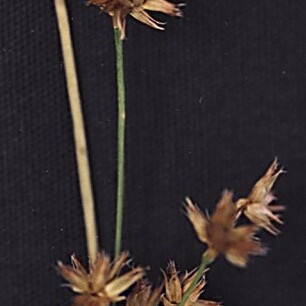Stems slender, erect, 1.5–4 dm, arising singly from the nodes of slender rhizomes that are evidently tuberous-thickened at intervals; cauline lvs 2 or 3, the blades terete, septate, 0.5–2 dm × 0.7–1.5 mm, sheath-membrane yellowish, prolonged into membranous auricles 0.5–1 mm; heads mostly 2–10(–15) in a loose or congested, proliferating infl, globose, 5–25-fld, mostly 6–9 mm thick; fls eprophyllate; tep acuminate, but broader than in no. 30 [Juncus torreyi Coville], 2.5–3.5 mm, the pet about as long as the sep; stamens 6; fr slender, sharply triquetrous, 3.5–4.5 mm, equaling or commonly surpassing the tep, tapering into a slender, only tardily dehiscent stylar beak, unilocular, the placental partitions only slightly intruded; seeds apiculate, ca 0.5 mm; 2n=40. Bogs, marshes, and wet shores; Nf. to Mack. and B.C., s. to Va., Ind., Mo., Tex., and Calif.


